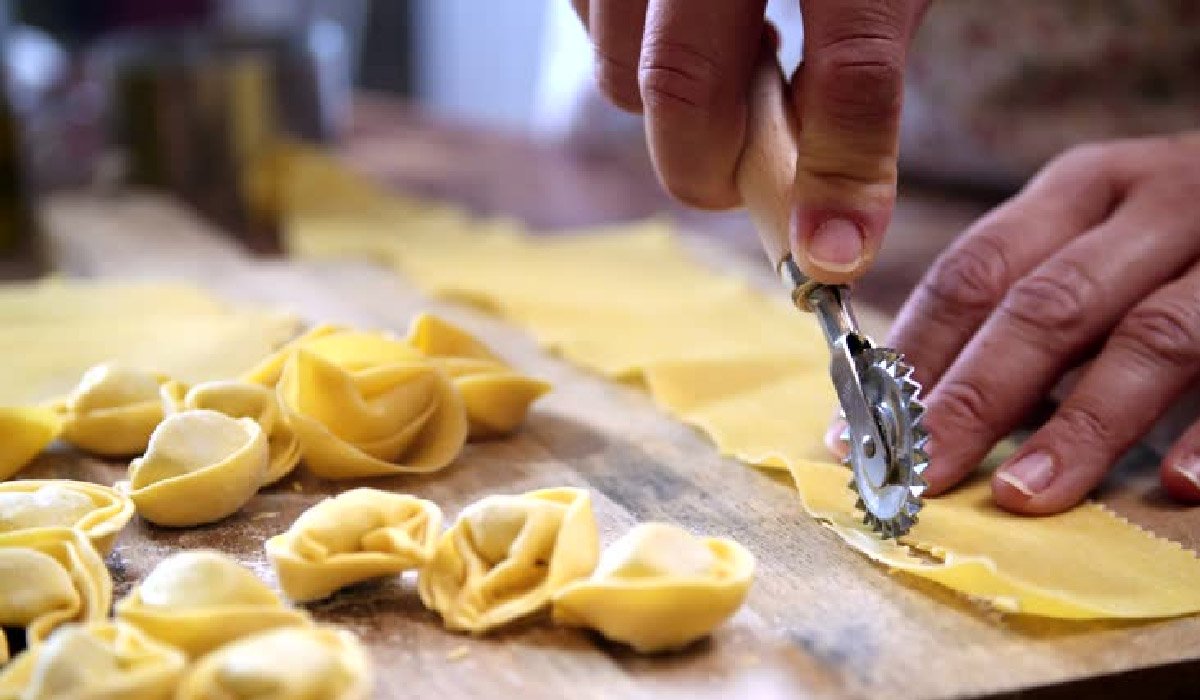Blog
Tortellinatrice Magic: Make Perfect Tortellini Fast at Home

What Is a Tortellinatrice?
A tortellinatrice is a specialized pasta-making machine designed to automate the process of creating tortellini—Italy’s beloved stuffed pasta. Derived from centuries-old culinary traditions rooted in the Emilia-Romagna region, this tool brings both art and engineering into the kitchen. In its simplest form, the tortellinatrice mimics the delicate, precise hand-folding of traditional tortellini, offering a more accessible, faster way to produce this classic dish.
It allows home cooks, chefs, and large-scale producers to replicate handmade quality at scale, ensuring uniform shape, even sealing, and consistent portioning. With its rising popularity in both restaurants and households, the tortellinatrice represents a brilliant fusion of old-world craftsmanship and modern convenience. This article explores its history, working process, machine types, maintenance tips, recipes, and the role it plays in preserving the heritage of Italian cuisine while embracing innovation in pasta-making.
The History and Evolution of the Tortellinatrice
Origin Story – From Bologna Kitchens to Modern Machines
Tortellini, those delightful ring-shaped pasta bites traditionally filled with meats or cheese, trace their origins back to the heart of Italy—Bologna and Modena. In these cities, grandmothers and artisans used to prepare tortellini by hand in a process that was nothing short of culinary poetry. Every piece was a symbol of love, tradition, and patience. Handmade tortellini required hours of work, with dough rolled thin, cut into perfect squares, filled precisely, then folded with care.
This labor-intensive method was a rite of passage in many Italian families and a defining aspect of regional pride. The earliest tools used to aid this process were simple wooden boards and metal cutters, but no automation was involved. As demand for tortellini grew beyond households and into trattorias and local markets, pasta makers began exploring ways to scale without sacrificing quality.
The Rise of the Machine
The tortellinatrice emerged during Italy’s post-World War II industrial expansion, when machinery began to enter even the most tradition-bound industries like food. As more people desired convenient access to artisanal-style pasta, small manufacturers started crafting mechanical devices that could replicate the folding process of tortellini. Early versions of the tortellinatrice were often manually operated and made of cast iron or aluminum, requiring the operator to feed dough and fillings by hand.
Despite being rudimentary by today’s standards, these machines dramatically increased production capacity for pasta shops and small restaurants. The machine allowed for consistent size, faster output, and less manual labor. Over time, as Italian cuisine expanded globally, the demand for machines that could make authentic tortellini at scale prompted further innovation and international adoption.
Modern Innovations
Today’s tortellinatrice machines are marvels of culinary engineering. Built primarily from stainless steel for durability and hygiene, modern units are equipped with adjustable settings for dough thickness, filling volume, and pasta size. Many come with digital controls and sensors that help automate every stage of the tortellini-making process. These machines not only enhance precision but also reduce food waste, making them ideal for eco-conscious kitchens.
Some even include attachments or modules that allow users to make other filled pasta types like ravioli or cappelletti. The advancement of technology has led to features such as programmable filling patterns, temperature control for dough softness, and even compact models designed for home use. The tortellinatrice has evolved into a reliable companion for pasta artisans who want to blend heritage with progress without compromising taste or texture.
How the Tortellinatrice Works – Step-by-Step Process
Components and Design
A standard tortellinatrice includes several essential components: a dough feeder or roller to flatten the pasta sheets, a filling hopper to dispense measured portions of the filling, a folding system that shapes the pasta around the filling, and a sealing/cutting unit that ensures each tortellino is securely enclosed and cleanly separated. The precision of the filling insertion and cutting mechanism is what gives each tortellino its consistent size and iconic shape.
The machine supports a variety of fillings including meat mixtures, ricotta cheese, spinach, pumpkin purée, or more modern vegan combinations. What makes the design especially clever is the ability to maintain the integrity of both dough and filling throughout the process without them drying or leaking.
Workflow Breakdown
| Step | Action | Description |
|---|---|---|
| 1 | Dough Input | Fresh pasta dough is rolled into thin, even sheets. |
| 2 | Filling Input | Filling is placed in the hopper and portioned precisely. |
| 3 | Molding | Dough folds around the filling to form a ring or twist. |
| 4 | Sealing | Pressure seals the edges to prevent leaks. |
| 5 | Cutting | Finished tortellini are cut and dropped onto trays. |
Customization Features
The best tortellinatrice models are known for their user-friendly customization options. Users can easily adjust the dough thickness to suit their preference, which is especially important for different pasta textures and cooking times.
Similarly, the filling density can be increased or reduced depending on whether the tortellini is for soup (lighter) or served as a standalone dish (heavier). Some machines come with interchangeable molds to create different pasta shapes and sizes, making the equipment more versatile. Additionally, many components are detachable and dishwasher-safe, ensuring hygienic and hassle-free maintenance for both home users and professionals.
Types of Tortellinatrice Machines
Manual Tortellinatrice
Manual tortellinatrice machines are best suited for pasta enthusiasts and small-scale chefs who want hands-on control while preserving traditional techniques. These machines typically consist of a crank mechanism and require physical effort to roll and fold the dough. While slower, they allow precise manipulation of the pasta, and are cherished by those who value authenticity. Their compact size makes them perfect for home kitchens. However, the learning curve and physical labor may be challenging for beginners or those making large batches.
Semi-Automatic Tortellinatrice
Semi-automatic versions are ideal for small restaurants or boutique pasta shops that need to increase efficiency without losing the artisanal touch. These machines automate parts of the process like filling and cutting, while still allowing manual control over the dough feed or folding adjustments. They strike a balance between modern convenience and traditional artistry, and are generally more affordable and easier to maintain than fully automatic systems. They also allow for quick recipe adjustments, making them popular among creative chefs.
Fully Automatic Tortellinatrice
For industrial pasta makers and high-volume restaurants, the fully automatic tortellinatrice is a game-changer. Capable of producing thousands of tortellini per hour, these machines operate with minimal human input. They come equipped with digital interfaces, programmable settings, and continuous-feed systems that streamline production. Despite the high initial investment, these machines offer unmatched speed, efficiency, and consistency. Their ability to produce large batches with near-zero waste makes them essential in commercial environments where time and output matter most.
Benefits of Using a Tortellinatrice
Using a tortellinatrice offers numerous benefits beyond just time-saving. First and foremost is the consistency—each tortellino is formed to the exact same size and sealed to perfection, ensuring even cooking and attractive presentation. This level of precision is hard to achieve with handmade methods, especially at scale.
The machine also allows users to control ingredients closely, making it ideal for gluten-free, vegetarian, or allergy-friendly options. It’s not only practical but fun, offering a creative and communal experience for families and food lovers. Economically, it reduces manual labor and long-term costs for restaurants and businesses. Whether you’re cooking for guests at home or running a pasta kitchen, a tortellinatrice ensures quality without compromise.
How to Choose the Best Tortellinatrice – Buyer’s Guide
Key Features to Consider
When choosing a tortellinatrice, several key factors can influence your decision. The build material is critical—stainless steel is durable, sanitary, and ideal for frequent use, whereas plastic models may be better for light home use and easier to clean. Consider capacity based on your kitchen needs. Do you cook occasionally, or are you producing pasta commercially? Ease of use is also essential. For beginners, a simple interface and clear instructions make a huge difference. Think about cleaning too—machines with detachable, dishwasher-safe parts save time and effort. Finally, consider versatility. Some models allow you to switch to ravioli or other pasta shapes, which adds to their value.
Comparing Top Brands
| Brand | Type | Capacity | Material | Price Range |
|---|---|---|---|---|
| Bottene | Automatic | High | Stainless Steel | $$$ |
| Imperia | Manual | Medium | Steel/Aluminum | $$ |
| KitchenAid | Semi-Auto | Medium | Steel Attachments | $$ |
Maintenance and Cleaning Tips
Maintaining your tortellinatrice ensures long-term performance and food safety. Always clean the machine after each use to prevent flour and dough buildup. Detachable parts should be rinsed in warm, soapy water or placed in the dishwasher if allowed. Avoid abrasive sponges or harsh cleaners that could damage the surface. Keep the machine in a dry area to avoid rust, and lightly oil any mechanical parts if recommended in the user manual. Regular inspections can catch worn-out parts before they break, especially in commercial environments. Treat your tortellinatrice like an investment—and it will continue to serve you well.
Best Recipes to Try with Homemade Tortellini
Classic Tortellini in Brodo (Broth)
A heartwarming traditional recipe, tortellini in brodo features small meat- or cheese-filled tortellini simmered in rich chicken or vegetable broth. It’s simple, elegant, and perfect for showcasing the delicate texture of freshly made pasta.
Creamy Mushroom Tortellini
Sauté mushrooms, garlic, and shallots in olive oil, then add heavy cream and grated Parmesan for a luxurious sauce. Toss with cooked tortellini for a vegetarian favorite that feels indulgent yet balanced.
Baked Tortellini Casserole
Layer cooked tortellini with marinara sauce and shredded mozzarella in a baking dish, then bake until bubbling and golden. This dish is perfect for gatherings or meal prep, and it freezes well too.
Fresh Garden Tortellini
Toss freshly made tortellini with halved cherry tomatoes, chopped basil, and a drizzle of extra-virgin olive oil. Add fresh arugula for a peppery bite. This dish is light, colorful, and great for summer.
Common Myths and Misconceptions
Some people believe that tortellinatrici make pasta less authentic, but this isn’t true. When using the same ingredients and folding technique, machine-made tortellini can be just as flavorful and traditionally shaped as hand-folded versions. Another myth is that only large factories use these machines, when in fact many models are designed specifically for home kitchens or small restaurants. Finally, many fear the machine is too complex, but most models today are extremely user-friendly and include easy-to-follow guides.
Tortellinatrice vs. Traditional Pasta Machines
| Feature | Tortellinatrice | Traditional Pasta Machine |
|---|---|---|
| Shapes | Tortellini only (specialized) | Fettuccine, spaghetti, etc. |
| Filling | Yes (stuffed pasta) | No (plain pasta only) |
| Use Case | Stuffed pasta creation | General pasta shaping |
| Speed | Fast, automatic/semi | Slower, manual |
Use in Restaurants, Pasta Shops, and Home Kitchens
In restaurants, the tortellinatrice ensures fast service while maintaining high culinary standards. In pasta shops, it helps fulfill large orders with artisan-level precision. At home, it allows pasta lovers to enjoy restaurant-quality tortellini with less time and effort. Whether for daily meals or special occasions, this machine brings professional results into any kitchen.
The Future of Tortellinatrice Technology
Looking ahead, future models may include AI-powered sensors that adjust fillings automatically, or Wi-Fi-enabled devices that sync with recipe apps for smart pasta programming. Eco-friendly models with energy-saving modes are already in development, and compact foldable designs are making their way into modern minimalist kitchens. The future is bright—and delicious—for the tortellinatrice.
Conclusion
The tortellinatrice is more than a machine—it’s a bridge between the past and the future of Italian cuisine. It preserves the craftsmanship of generations while embracing the needs of today’s fast-paced world. For home cooks, restaurant chefs, and pasta lovers alike, investing in a tortellinatrice is a step toward culinary excellence. It empowers anyone to enjoy the tradition, taste, and joy of homemade tortellini with confidence and creativity.
FAQs About Tortellinatrice
What is a tortellinatrice used for?
A tortellinatrice is a pasta-making machine used to make tortellini quickly and easily. It helps shape, fill, and seal the pasta so you don’t have to do it all by hand. This machine makes sure every tortellino is the same size and perfectly made.
Can I use a tortellinatrice at home?
Yes, you can use a tortellinatrice at home. Many models are small, affordable, and easy to use. They are great for families or anyone who loves homemade pasta. Some are manual, and others are electric for even faster results.
What types of fillings can I use in a tortellinatrice?
You can use many types of fillings in a tortellinatrice, such as cheese, meat, spinach, mushrooms, or even vegan options. Just make sure the filling is smooth and not too wet so the machine works properly and seals the pasta well.
Is a tortellinatrice easy to clean?
Yes, most tortellinatrice machines are easy to clean. Many parts come off and can be washed by hand or in the dishwasher. Always clean it right after using it to keep it working well and to avoid dried dough sticking inside.
What is the difference between a tortellinatrice and a pasta maker?
A tortellinatrice makes filled pasta like tortellini, while a regular pasta maker only rolls and cuts flat pasta like spaghetti or fettuccine. A tortellinatrice adds the filling and shapes the pasta, making it perfect for stuffed pasta dishes.
For More Information Visit Coopermagazine
-

 Celebrity1 year ago
Celebrity1 year agoWho Is Jennifer Rauchet?: All You Need To Know About Pete Hegseth’s Wife
-

 Celebrity1 year ago
Celebrity1 year agoWho Is Mindy Jennings?: All You Need To Know About Ken Jennings Wife
-

 Celebrity1 year ago
Celebrity1 year agoWho Is Enrica Cenzatti?: The Untold Story of Andrea Bocelli’s Ex-Wife
-

 Celebrity1 year ago
Celebrity1 year agoWho Is Klarissa Munz: The Untold Story of Freddie Highmore’s Wife
















